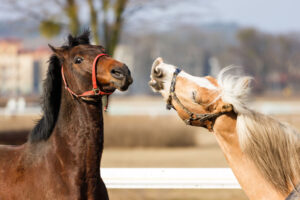 For many, horses represent grace, strength, and a strong sense of companionship. However, just like any other relationship, having a deeper understanding of your horse often comes down to communication. Horses mainly rely on body language to convey their emotions, unlike humans. Being able to identify these cues can significantly strengthen the connection between the horse and its owner.
For many, horses represent grace, strength, and a strong sense of companionship. However, just like any other relationship, having a deeper understanding of your horse often comes down to communication. Horses mainly rely on body language to convey their emotions, unlike humans. Being able to identify these cues can significantly strengthen the connection between the horse and its owner.
The Basics of Equine Communication
Before diving into the specifics, it’s crucial to grasp the fundamentals! As prey animals, horses have developed the ability to communicate with their herd using subtle cues. Although they don’t communicate as humans do, every movement of their body, such as a flick of an ear, a swish of a tail, or a shift of weight, carries significant meaning. By learning to recognize and interpret these signals, we can establish better communication and a more harmonious relationship with horses.
Eyes and Eyelids
The eyes, often referred to as the windows to the soul, are a significant indicator of a horse’s emotional state. Bright and attentive eyes usually indicate curiosity or alertness, while half-closed eyes, especially when accompanied by a relaxed posture, might mean that the horse is content or drowsy. However, if the horse’s eyes appear white-rimmed or wide open with a tense body, it could be a sign of fear or alarm.
Ears and Their Movements
Did you know that a horse’s ears act like a radar system? They constantly move and tune into sounds and signals around them. If a horse’s ears are pricked forward, it could indicate interest or curiosity about something in front of them. On the other hand, if their ears are sideways, it might mean that the horse is relaxed or not particularly focused on anything. However, if their ears are pinned back, it could indicate irritation, fear, or aggression. It’s important to pay attention to the horse’s entire body language, including their ears, to understand their behavior completely.
Tail Position and Movements
The horse’s tail serves as a means of expression. A relaxed tail generally implies a happy horse, while a slightly raised tail signals excitement or alertness. A tail that is pressed down could indicate fear or discomfort. A vigorously swishing tail, particularly when the rest of the body is tense, might also indicate irritation or annoyance.
Head Position and Movements
The way a horse holds its head can communicate various emotions. A horse with a high head, flared nostrils, and wide eyes might be expressing fear or excitement, while a lowered head usually indicates a state of calmness. However, if a horse’s head is too low, almost touching the ground, and with droopy ears, it could indicate illness or extreme submission.
Leg and Hoof Signals
Just as with humans, horses use their legs to convey emotion. A horse stamping its foot could be showing impatience or trying to shake off flies. Pawing at the ground can signify anticipation, especially if expecting food, or it could display anxiety. A raised rear leg, meanwhile, is a defensive posture, signaling that the horse might kick.
Skin Twitches and Body Shivers
Subtle skin twitches, especially around the flank, often mean a horse is trying to dislodge a fly. However, repeated shivers or more pronounced skin twitches can indicate the horse is in discomfort or pain. It’s essential to monitor these signs, especially if they are frequent, as they can be an early indication of health issues.
When we learn how to identify and understand the communication cues of horses, we can improve our bond with them and ensure their well-being and happiness.
Offering a safe, comfortable environment is paramount for those dedicated to providing the best for their equine companions. A custom horse barn or run-in shed can be tailored to meet your horse’s unique needs, ensuring they have a sanctuary where they feel secure and content.
Discover the possibilities available at Deer Creek Structures for your equine friends by calling (254)546-2276 or filling out a custom barn form online today!
